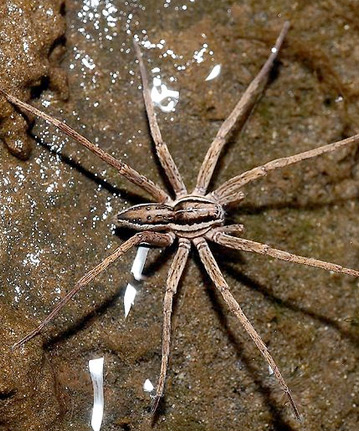Invertebrates 101 Chapter 5
Arthropods - The Fishing Spider
If you’re out early in the morning or near dusk you may notice a large spider with striking, elegant stripes hanging out on the surface of the pond, its long legs extended across the water surface. This is Dolomedes, the Fishing Spider, 9 species of which live in the US. Like the Water Striders which are a common prey insect, the Fishing Spider has hydrophobic, or water repellent, hairs that allow it to move easily across the surface of the water, which they use in the same way as other spiders use webs. Insects that fall into the water cause vibrations that the spider senses, determining not only the direction of the prey but the precise distance as they quickly skate out and grab it. They can even take very small fish, submerging under the water to grab them while they breath air trapped in the hairs on their bodies. They are mostly nocturnal hunters, staying out of sight during the day to avoid being eaten by birds and snakes, their primary predators.
Fishing Spiders help keep insects at bay and are harmless to humans, and only rarely take the smallest of fish, so their impact on the pond is negligible, but they’re pretty cool to watch!
If you’re out early in the morning or near dusk you may notice a large spider with striking, elegant stripes hanging out on the surface of the pond, its long legs extended across the water surface. This is Dolomedes, the Fishing Spider, 9 species of which live in the US. Like the Water Striders which are a common prey insect, the Fishing Spider has hydrophobic, or water repellent, hairs that allow it to move easily across the surface of the water, which they use in the same way as other spiders use webs. Insects that fall into the water cause vibrations that the spider senses, determining not only the direction of the prey but the precise distance as they quickly skate out and grab it. They can even take very small fish, submerging under the water to grab them while they breath air trapped in the hairs on their bodies. They are mostly nocturnal hunters, staying out of sight during the day to avoid being eaten by birds and snakes, their primary predators.
Fishing Spiders help keep insects at bay and are harmless to humans, and only rarely take the smallest of fish, so their impact on the pond is negligible, but they’re pretty cool to watch!





